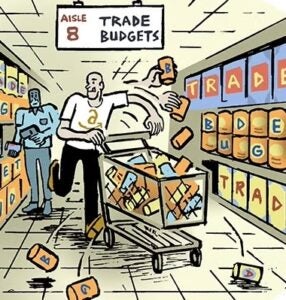 “Data-Driven Thinking” is written by members of the media community and contains fresh ideas on the digital revolution in media.
“Data-Driven Thinking” is written by members of the media community and contains fresh ideas on the digital revolution in media.
Today’s column is written by James Avery, CEO at Adzerk.
The rise of ad blocking is a symptom of a real problem: Ads suck. To slow the adoption of ad blocking and make the Internet a better place, we need to make advertising better.
I don’t believe we can outsmart the ad blockers from a technology perspective. Though not a perfect comparison, piracy offers an example of the futility of trying to out-hack the hackers. More than 15 years after Napster’s founding, any 15-year-old can find and download any movie, song or game for free, despite millions of dollars poured into digital rights management and other “solutions.”
Industries dealt with piracy is by making products easier to buy. When I can pay $12 a month for HBO Now, I don’t need to figure out how to bootleg “Game of Thrones.” The solution isn’t to try and out-hack the ad blockers. It is to change our model so it’s more acceptable to users.
In my experience, better ads create lower ad-block rates. This is why I believe the IAB or another publisher-focused organization should create a new guideline called the Quality Ads Initiative.
A Vision For Better Advertising
Users install ad blockers because ads are crappy, there are too many of them, they impact computer performance and consumers feel like their privacy has been violated.
The guideline I propose would dictate several simple rules that would improve online advertising for all. An important distinction is that this should apply to all users, not just users running ad blockers. If we want to stem the growth of ad-blocking installations, we have to deter people before they click the install button.
Honor the EFF’s ‘Do Not Track’ policy: If a user does not want to be tracked, they shouldn’t be tracked. The Electronic Frontier Foundation built a reasonable policy that takes the privacy issue off the table. For non-DNT users, we should all agree to use a secure sockets layer for all communications and adopt reasonable security and privacy defaults. Consumers shouldn’t have to click DNT to to ensure their data is safe.
No more Flash: This is easy now in light of Google’s plans, but we shouldn’t have to wait for Google. Flash causes performance and security issues, and no IAB member should be using it. This should have been done years ago.
No more popups or interstitials: Pop-ups are largely not a problem anymore because of pop-up blockers, not because the ad industry woke up and put a stop to it. Interstitials are still a problem, though, especially on mobile. If we want to stop mobile ad blocking before it starts, this is where to begin. They are intrusive, cause accidental clicks and need to disappear.
No CPU-intensive ads: This should largely go away with Flash, but it’s possible to write bad ads with HTML5 as well. All ads should be tested to ensure they don’t cause excessive use of computers’ central processing units. I installed an ad blocker on my mom’s computer because Flash ads caused it to crash. Don’t ruin the user experience with poorly performing ads.
Reasonable ad and connection limits: Another cause of poor performance and annoyance is the number of ads and connections per page. Let’s come up with a reasonable content-to-ad ratio and a max for the number of connections allowed. Some pages download more data for ads than they do for content, which is a big deal for performance as we move to browsing the Internet on our phones.
Only viewable ads: This ties into the previous rule. The industry loads billions of ads a month that users never see. Those ads still slow down computers and cost bandwidth. The technology for only loading ads when they are viewable or about to be viewed by a user is fairly simple.
No unskippable video ads: Video ads are one of the largest reasons people install ad blockers, so they should be skippable or less than 15 seconds long. The days of watching a 60-second ad to see a 30-second clip should be over.
No more distasteful ads: You know them – huge cleavage, things that look disturbingly like male genitalia and advertise testosterone, and sometimes much worse. Most ad tech companies already screen for these, but they all should if they want to be considered compliant.
A global floor price: Right now impressions routinely clear at 1 cent per thousand impressions to a publisher. Maybe if advertisers aren’t willing to pay a reasonable amount, we shouldn’t show an ad or we could substitute something useful in its place. There is a cost to the user of every ad we show, in both bandwidth, performance and attention. This could be a low-cost way to raise CPMs and lower the number of crappy ads, with minimal loss to publishers.
The goal of this policy is twofold. The first is to help prevent the growth of ad blocking, but it can also help recover current ad-blocking users.
Making Up With Ad-Block Users
Once this policy is in place, we can do two things to recover ad-block users.
First, we can help publishers create a simple notification to users who have ad block installed to educate them about this guideline. With one click, they can unblock the ads from this publisher. Calls to be unblocked don’t always work, but with a policy in place it can work for quality publishers.
Secondly, we can work with the existing ad-block companies to add the option to only block ads that don’t conform to these guidelines. This is why it’s important not to sue them. They have the ability and have shown the willingness to do this. Adblock Plus runs an Acceptable Ads program that has received negative press due to payments from some publishers to make the list, but other publishers haven’t paid thanks to high-quality ads. The ad industry could even create its own blocker that blocked non-guideline ads, or get browsers to build it in.
We have an opportunity to stem the install of ad blockers, recover users who are using ad block and make the Internet a better place by putting something like this in place. But the guideline could produce other benefits, such as a premium for ads that follow the guideline. It should also reduce inventory, which would help raise CPMs. With less bad inventory, the publishers and content that offer high-quality, viewable impressions would make more money.
This guideline can be good for publishers, advertisers and users. Without it, the situation will get worse – and soon.
Follow Adzerk (@adzerk) and AdExchanger (@adexchanger) on Twitter.












